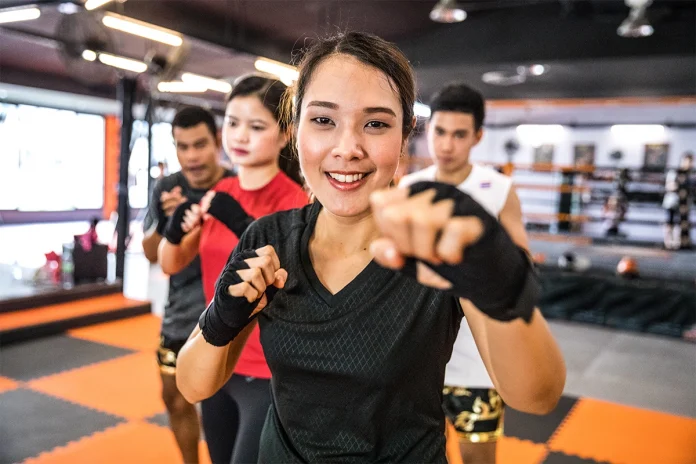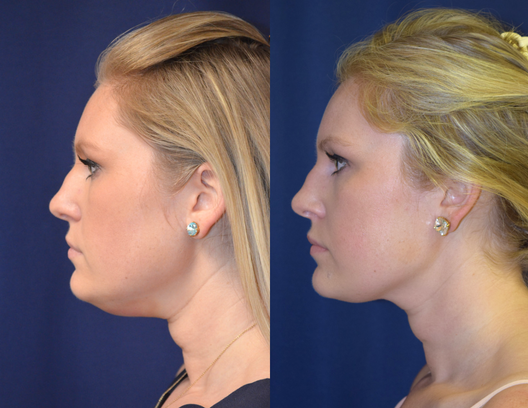Kickboxing classes may not be as popular today as they were in the late ’90s, but people still love to hone their skills with this cross-training option. Whether you have taught kickboxing for years or are just getting started, it’s a good idea to review the foundational concepts that make up this total-body workout.
Kickboxing classes can be structured in a variety of ways, from traditional cardio that incorporates 32-count combinations to high-intensity interval training. And yet the base techniques and movements are the same. Given the technical nature of kickboxing, it’s vital for participant (and instructor) safety that you set up properly and cue body mechanics precisely. When you demonstrate techniques correctly, you “gift” attendees with the knowledge they need to execute each punch, kick or combination successfully. Another plus to emphasizing the fundamentals: You progress participants gradually from basic techniques to more advanced ones.
The ABCs of Kickboxing Body Mechanics
The foundation for all techniques lies in lower-body mechanics, beginning with the “ready” or “fight” stance: one leg in front of the other or feet parallel, with legs shoulder-width or slightly wider apart. The next component is footwork: a boxer’s shuffle to stay light on the feet, and the heel “release” when punching to gain power and to protect joints. The hips are the primary movers for generating force. When you’re punching, the hip leads and the punch follows. The shoulders also move with the hip to create one coordinated movement, maximizing force generation. The head stays neutral, and the eyes focus on the target.
Body Mechanics: Tips and Cues
- Release the heel of the punching side to allow the hip to drive forward.
- Keep the arm and fist relaxed throughout the punch, and tighten at the point of contact. Relax the arm and fist as you return to starting position.
- To reduce neck strain, relax the shoulders when punching.
- Keep the nonpunching fist at the chin throughout the movement; lift the arms for balance during kicks.
- Visualize a specific target in front of you.
- While you don’t want to hyperextend the joints, do maximize range of motion by extending fully.
- Emphasize a quick, strong and purposeful rechamber phase, as rechambering is an important part of the workout.
Basic Kicking Techniques
Kicks are the fundamental striking techniques for the lower body. Basic kicks include back, round (or roundhouse), side and front. When instructing kicks, emphasize the position of the base foot, the knee before the kick and the striking part of the foot. To protect the knee joint, always keep the base leg slightly bent, and don’t hyperextend the kicking leg’s knee. Here are specifics for each kicking technique.
BACK KICK
- Starting position: Ready/fight stance.
- Movement: Turn head to look over shoulder of kicking leg. Lift knee toward chest, foot flexed. Drive heel behind you, toes down, striking with heel. Keep kick at hip level or lower to protect lower back.
- Rechamber: Pull knee back to chest, and lower foot to floor.
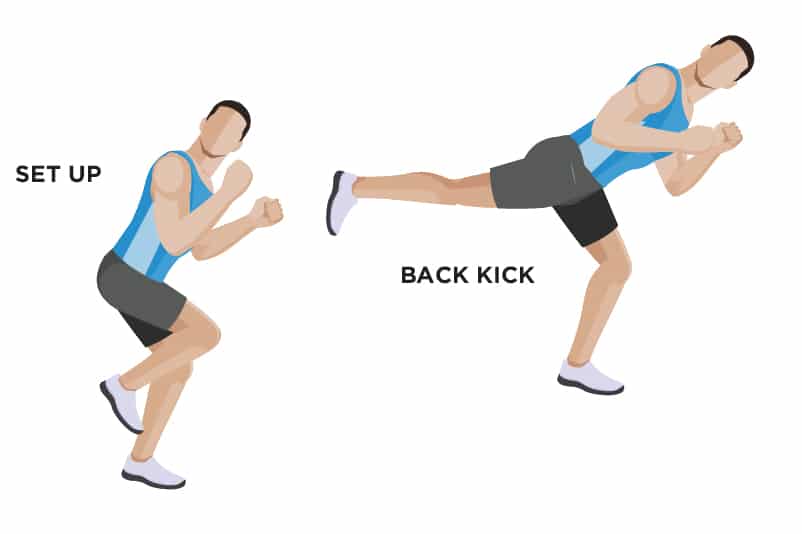
ROUND KICK
- Starting position: Ready/fight stance.
- Movement: Pivot back foot (base leg) toward back of room as you lift front knee. Hip is open, and lifted leg is rotated (think “front kick on its side”), knee pointing to target, heel pulled toward glute. Extend knee to kick target, pointing toe and striking with top of foot.
- Rechamber: Pull heel back to glute, and lower foot to floor.

SIDE KICK
- Starting position: Ready/fight stance.
- Movement: Pivot back foot (base leg) toward back of room as you lift front knee. Lifted knee draws toward chest (as if you’re hugging your knee). Heel, hip and shoulder of kicking leg are aligned. Push heel toward front of room, extending toward target. Toes point downward, foot flexed, striking with heel.
- Rechamber: Bend knee, and lower foot to floor.
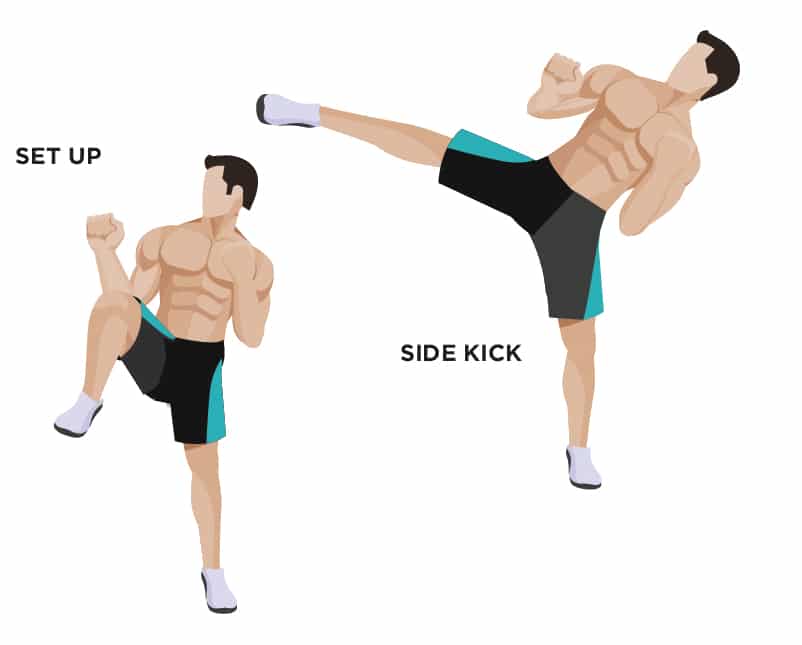
FRONT KICK
- Starting position: Ready/fight stance.
- Movement: With hips square to front, lift
one knee straight up toward chest. Extend knee to kick forward, aiming with ball of foot. Base foot is slightly turned out. - Rechamber: Bend knee in, and lower foot to floor.
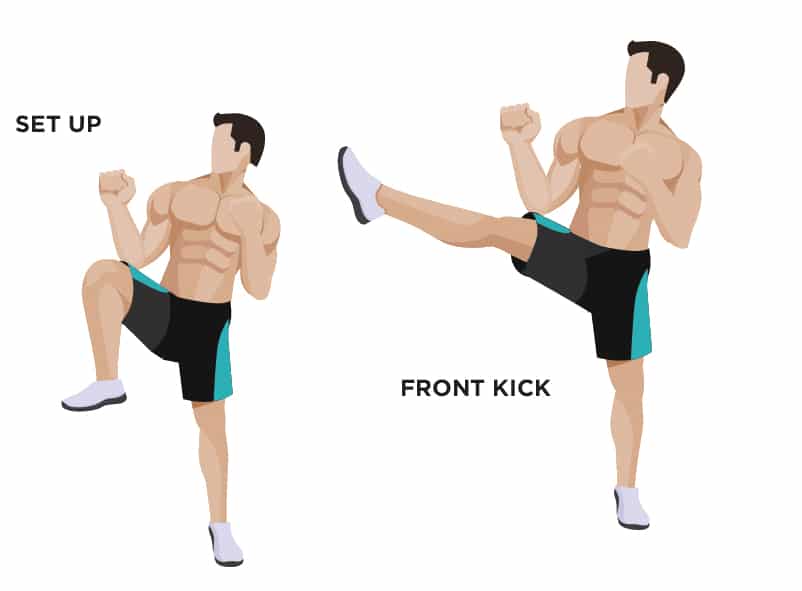
Basic Punching Techniques
Punches are the fundamental striking techniques for the upper body. Basic punches include jabs, crosses, hooks and uppercuts. Instruct participants to make a fist with the fingers curled in and the thumb bent over the top of the fingers, placed between the second and third knuckles (first knuckle is at the base of the finger). Wrists remain straight when punching, and elbows should never hyperextend or lock. Here are specifics for each punching technique.
JAB
- Starting position: Ready/fight stance, elbows bent, fists slightly below chin (guard position).
- Movement: Extend lead arm straight to front, aiming with first two knuckles of fist (i.e., first knuckles of index and middle fingers). Back arm stays bent, fist by chin.
- Rechamber: Bend elbow, and draw fist back to starting position.
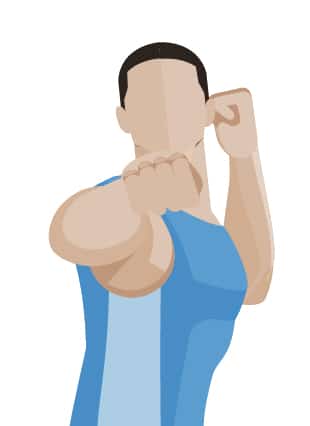
CROSS
- Starting position: Ready/fight stance, elbows bent, fists slightly below chin.
- Movement: Rotate back hip and lift heel to drive back arm forward, aiming with first two knuckles of fist. Front arm stays bent, fist by chin.
- Rechamber: Lower heel as you pull hips and fist back to starting position.

HOOK
- Starting position: Ready/fight stance, elbows bent, fists slightly below chin.
- Movement: Front or back arm can perform hook, with punching arm’s elbow lifted so that arm is parallel to floor, elbow bent at a 90-degree angle. Punch across face, striking with first two knuckles of fist, lifting same-side heel and rotating striking-side hip to produce more power.
- Rechamber: Lower heel as you pull elbow and fist back to starting position.

UPPERCUT
- Starting position: Ready/fight stance, elbows bent, fists slightly below chin.
- Movement: Front or back arm can perform uppercut. The hip on punching side rotates forward; heel lifts to drive punch forward and up, as if punching someone under the chin.
- Rechamber: Lower heel as you pull elbow and fist back to starting position.

Kickboxing Transitions and Combinations
After instructing each individual movement, you can begin to put several techniques together to form combinations. To achieve seamless transitions when building combinations, be aware of the body position following a movement. This is a key concept. For example, instead of a front kick following a hook with the front arm, a front-leg side kick would be more appropriate since the hip is already positioned appropriately.
To create easy-to-follow combinations, incorporate a mixture of upper- and lower-body techniques, as well as basic moves such as jumping jacks, jump ropes, speed bags or squats. Since participants are more familiar with these exercises, placing them at the end of the combination provides an opportunity to refocus attention on the next kickboxing move. In addition, basic moves can serve as a transition from one lead side to the other.
Tips for Teaching Combinations
- Teach longer combinations by instructing the first few movements, then gradually adding the next technique until the full combination is created (i.e., layer movements to build the combination).
- Consider starting upper-body combinations with a lead hand jab, as it is a more natural setup for the cross, hook and uppercut, which are more powerful punches.
- Music speed is important. Faster tempo may require slower execution (e.g., each movement may take 2 counts to perform as opposed to 1 count).
- Since these techniques are not natural movements performed on a daily basis, keep the number of repetitions in mind, as well as the speed. Do not sacrifice quality for quantity or speed.
- Incorporate rhythm into your combinations with different pacing or counts. For example, in a double jab + cross + hook + uppercut combination, each jab is 1 count, while the cross, hook and uppercut are 2 counts each.
Kickboxing Success: Be Precise and Powerful
Regardless of your kickboxing class format, it’s important to teach proper technique, understand body mechanics, cue form and safety, and develop combinations that make sense mechanically and are easy to perform. By applying these teaching strategies to your classes, you can help participants feel more successful, experience a fun and engaging workout, and build a strong kickboxing foundation that prepares them for more advanced movements. See also
